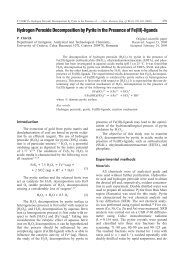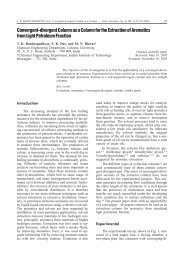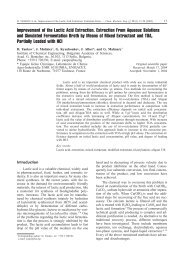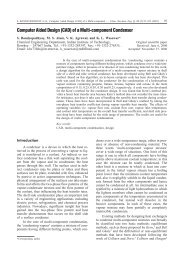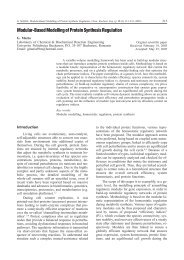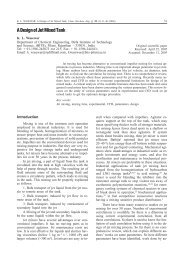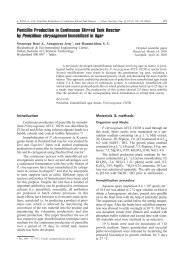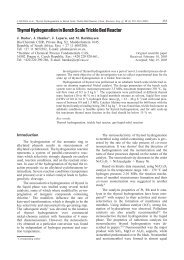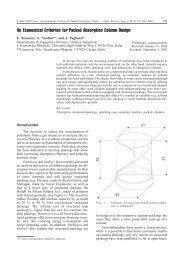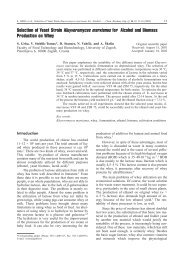Solid State Fermentation: An Overview - pierre
Solid State Fermentation: An Overview - pierre
Solid State Fermentation: An Overview - pierre
Create successful ePaper yourself
Turn your PDF publications into a flip-book with our unique Google optimized e-Paper software.
66 S. BHARGAV et al., <strong>Solid</strong>-state <strong>Fermentation</strong>: <strong>An</strong> <strong>Overview</strong>, Chem. Biochem. Eng. Q. 22 (1) 49–70 (2008)Exo-polysaccharides production under SSFExo-polysaccharides such as succinoglycan,xanthan are the future products of SSF. 65 Agrobacteriumspp. has been used for succinoglycan productionon an industrial scale as they are non-pathogenicand produce good yield of polysaccharide.Succinoglycan was produced using Agrobacteriumtumaefaeciens on agar medium, spent malt grains,ivory nut and grated carrot in a horizontal bioreactor.176Similarly, Xanthomonas compestris was grownon a variety of solid substrates such as spent maltgrains, apple pomace and citrus peels for xanthangum production. <strong>Fermentation</strong> was done in rotatingculture bottles. 177Production of biocontrol agents under SSFDevelopment of sustainable agriculture througheco-friendly pesticides is needed due to their stabilityand reliability. They are used as an alternative totoxic residues. Among the various microbial agentsas biocontrol agents, fungal agents are found tohave greater potential because of their differentmodes of action. Liagenidium giganteum, a fungalagent used for control of mosquitoes, act by encystingon their larvae. It uses the larvae as a substratefor growing by entering inside it. This fungus actsby producing motile zoospores. 30The recognition of the fungal strain with pesticideactivity is significant for development of infectivepropagules such as conidiospores, blastospores,chlamydospores, oospores and zygospores, 65 alongwith assessment of its biocontrol activity. Similarly,the mechanism of infection is also an important parameterto be considered for large-scale productionstrategy. 3 Retention of moisture is an important aspectfor development of biopesticide formulation.Vrije et al. 179 illustrated the various mode of actionand requirements of down stream processing for thebiocontrol agents.Spores produced in SSF are more heat resistantand are more stable through SSF. 70 Heat evolutionand retention are the big problem in SSF system,but using lignocellulosic substrates, which increasethe water retention capacity and forced aeration, 178can prevent it.E. nigrum produced on peat, vermiculite andlentil meal is an antagonist of Monilinia laxa, responsiblefor loss in stone fruits. Production usingSSF is done in plastic bags because increasing thenumber of bags can do scale-up. 180 A glass columnreactor was used with forced aeration with differentsubstrate bed height and diameter for the productionof spores of Metarhizium anisophilae. Forcedaeration reduces heat transfer. 128 Similarly, a packedcolumn bed reactor has been used to study interactionsbetween Fusarium culmorum and its potentialbiocontrol agent, Trichoderma harzianum.<strong>Solid</strong>-state fermentation of broiler litter has beendone for the production of spores of B. thuringenesisand P. flourescens. 181 Oostra et al. used mixedbioreactors for large-scale production of spores forbiocontrol agent Coniothyrium minitans and evaluatedthe heat produced during the process. C.minitans has the ability to grow and sporulate in awide temperature range and is responsible for controllingSclerotinia sclerotinium infections. 50Production of biofuel by SSFEthanol is the most widely used biofuel today.Although it is easier to produce ethanol using submergedfermentation, SSF is preferred due to itslower water requirement, smaller volumes of fermentationmash, prevention of end product inhibition,and disposal of less liquid water, which decreasespollution problems.Cellulosic materials are receiving major attentionfor ethanol production because of their abundantavailability. 182 <strong>Solid</strong>-state fermentation of applepomace supplemented with ammonium sulfate andcontrolled fermentation with Saccharomyces cerevisiaehas been reported to produce ethanol. 183 Kargi etal. used the rotating drum fermentor to estimate theinfluence of rotational speed on the rate of ethanolformation. The rate of ethanol formation decreasedwith the increase in rotational speed. 184 Various spp.of yeasts that can be used for ethanol production bySSF are Saccharomyces cerevisiae,Kloeckera apiculate,Candidastellata,Candida pulcherrina andHensenula anomala. Bacteria like Zymomonas mobilisand fungus like Fusarium oxysporum also havethe ability to produce ethanol. Ethanol productionusing thermotolerant yeasts has been supported becauseof lower cooling costs required and faster determinationrates. 149,185 Various substrates that can beused for alcohol production are sweet sorghum,sweet potato, wheat flour, rice starch, soluble starchandpotatostarchusingSaccharomyces cerevisiae.However, maximum ethanol production is achievedby using mixed substrates. 186,187ConclusionsThere is a continuous development in SSFtechnology over the last two decades. The advantagesof SSF processes overweigh the obstacles dueto engineering problems involved in fermentationprocesses. Presently, in most SSF systems fungi aremore suitable than bacterial strains and yeasts, butgenetically improved or genetically modified bacterialand yeast strains may be made to suite SSF processes.Bacterial cultures decrease the time required



